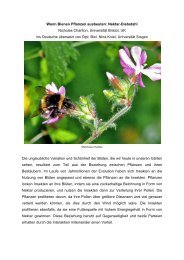PhDâ€theses - Ethologische Gesellschaft
PhDâ€theses - Ethologische Gesellschaft
PhDâ€theses - Ethologische Gesellschaft
Create successful ePaper yourself
Turn your PDF publications into a flip-book with our unique Google optimized e-Paper software.
RELEVANCE OF ACOUSTIC PARAMETERS IN THE SPECTACLED PARROTLETS´<br />
(FORPUS CONSPICILLATUS) CONTACT CALL<br />
Miriam Waldmann<br />
miriamwaldmann@hotmail.com<br />
Research Update<br />
Diploma thesis, supervised by Dr. R. Wanker and Prof. Dr. J. Schneider, Department of Biology,<br />
Zoological Institute & Museum, University of Hamburg<br />
A fundamental attribute of the human language is its complex structure, which enables us to<br />
communicate in sentences. It is still not known how the ability for syntax evolved. One<br />
hypothesis is that complex social structures facilitated this ability (Social Brain Hypothesis).<br />
The Machiavellian Intelligence or Social Brain Hypothesis assumes that brain evolution was<br />
determined by complex social systems. Investigating cases of convergent evolution of<br />
communication is a particularly promising approach in this context. Spectacled parrotlets<br />
evolved a sophisticated communication and with their contact calls they transmit<br />
information about who is calling, which bird is called and which group the caller belongs to.<br />
In this study, I examined whether the information embedded within the contact call of the<br />
spectacled parrotlets (Forpus conspicillatus) is structured. Firstly, I compared results of<br />
previous theses about contact calls. I found that different combinations of the call<br />
parameters contain different information. The relevant call parameters are minimum and<br />
maximum frequency, bandwidth, start and end frequency, peak frequency (maximum<br />
accentuated frequency), call duration and modulation (this means changes of direction in<br />
the fundamental frequency from rising to falling and vice versa). Secondly, I used playback<br />
experiments and compared responses to natural and artificially modified calls to verify the<br />
units responsible for coding receiver identity. The modified calls elicited responses and these<br />
responses differed from controls in the number of replies. The manipulation was successful<br />
in that calls were recognised but the information about the receiver was no longer present.<br />
More such studies are required to elucidate how further information is coded within the<br />
structure of the contact call.<br />
24



